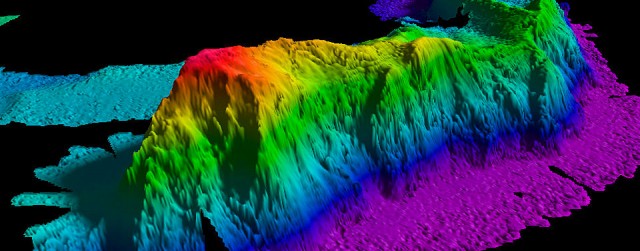seamounts
SEAMOUNTS ARE MOUNTAINS more than 3,281 ft (1,000 m) high that rise from the seafloor and do not break the water's surface. Some seamounts occur thousands of meters beneath the ocean surface, while others are only dozens of feet from the surface. Seamounts vary in form as well—seamounts whose tops have been truncated by wave action resemble volcanic cones. Some seamounts are still growing; the Tabango Seamount near the PHILIPPINE islands of Leyte and Cebu grew a total of 32.8 ft (10 m) from 1992 to 1997.
Seamounts are found in every latitude and ocean basin, and it is estimated that there are tens of thousands of such undersea mountains under the world's oceans. Together with deep ocean basins and seafloor trenches, the presence of seamounts suggests a highly complex ocean topography, much of which has not yet been explored. The first to be termed a seamount was the Davidson Seamount off the CALIFORNIA coast in 1933, but it was only in recent decades that there has been scientific interest in their natural and physical characteristics.

The origins of many seamounts are still being debated by scientists, as some isolated seamounts and seamount chains formed near midocean ridges as hot spot volcanoes on new oceanic crust, while others were formed through their eruption over much older oceanic crust; the origins of the latter are more uncertain. Seamounts are more commonly found in chains or groups, and these tend to be volcanic in origin. Isolated seamounts and those not formed from volcanic activity but by uplift tend to be less common; examples include the Great Meteor Seamount in the northeast ATLANTIC OCEAN. Seamounts with volcanic origins include the Loihi and the Emperor Seamounts, both of which are part of the Hawaiian Ridge-Emperor Seamounts chain that comprises more than 80 large volcanoes and extends some 3,728 mi (6,000 km) from the Big Island of Hawaii to the Aleutian Trench off ALASKA. Some of these seamounts, like the 9,842-ft- (3,000-m-) high Loihi, are active volcanoes. The individual seamounts of the Emperor Seamounts chain were named by Robert Dietz in 1954 for the emperors of JAPAN, notably Kimmei, Nintoku, Suiko and Yuryaku, and the chain is thought to be formed by the movement of the North Pacific Plate over the stationary Hawaiian hot spot.
Apart from the interest in their geologic origins, seamounts also make excellent laboratories for understanding patterns of marine biogeography and diversity. Seamounts are areas of high biological production as their physical projection toward the sea surface and toward zones of sunlight penetration provides hospitable conditions for marine habitats, including those supporting commercially viable fish and coral. As a result, seamounts are “oases” in the open ocean teeming with rich marine life. In addition, seamount habitats are possible centers of speciation and display high degree of endemism, supporting plants and animals that do not occur anywhere else or are genetically removed from their nearest neighboring population. Seamounts also appear to be important stopping points for large migratory animals such as whales, which use these features as navigational aids.
Seamounts are large landform features and can significantly influence water masses and water circulation patterns of the surrounding ocean, acting as obstacles around which water currents may be diverted. As a result, seamounts may deflect deep ocean currents and bring about the upwelling of nutrient-rich waters from the deep sea into the near-surface zones where sufficient light can penetrate to allow for photosynthesis, thereby enhancing biological production and biodiversity in the areas around them. Much of this rich reservoir of biodiversity on seamounts remains to be studied.
Together with the economic dependence of people on fish catch in seamount environments, the unique ECOSYSTEMs and vulnerable marine populations found on seamounts have led to calls for the careful management of such environments, especially since less than half (47 percent) of seamounts fall inside exclusive economic zones (EEZs) as Marine Protected Areas (for example, the Tasmanian Seamounts Marine Reserve in Tasmania, AUSTRALIA). The rest occur in international waters and are therefore vulnerable to international exploitation.